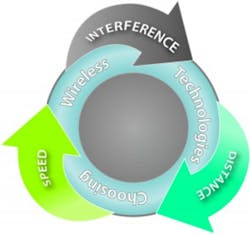Using wireless technology provides many advantages, such as time and cost savings, for engineers in the process industry. Various wireless solutions exist for each application, but one solution for all applications is not on the market. It is important to make sure that all components of a wireless network are chosen correctly to ensure reliable operation. This article will serve as a guide in what to look for to find the most reliable wireless solution for well-pad applications.
Figure 1. Building a reliable wireless network requires a balance of interference, distance and speed. Courtesy of Phoenix Contact.
With the process industry struggling in the U.S., it is more important than ever to focus on efficient design and installation practices in existing and new installations using industrial-grade wireless technology. Compared to wired solutions, wireless has many advantages. It can reduce installation and maintenance costs, cover longer distances, and get around obstacles easier. If designed correctly, wireless solutions can fit into nearly any process installation. With wireless, many factors need to be examined before settling on a specific technology and its components.
To build a reliable wireless network, the installer needs to look at three main factors: interference, distance and speed (see Figure 1).
Interference from other radios
Interference in the area around a network will cause the signal between the radios to weaken and possibly lose connection. It can come from other radio frequency-(RF) transmitting devices or obstacles in the area, so the installer must identify these before designing the network.
Other RF devices in the area could send a signal on the same frequency as the radios in the new network being installed. This can lead to reliability problems such as packet loss and radio connection issues. If other RF-transmitting devices in the area have been identified, building a system around those devices can improve reliability.
Two common types of RF-transmission technologies are direct sequence spread spectrum (DSSS) radios and frequency-hopping spread spectrum (FHSS). DSSS radios operate on a single channel with signals hopping across the full bandwidth of that channel, while FHSS signals hop from frequency to frequency in a pseudorandom pattern. This makes FHSS better for areas with many RF-transmitting devices as it is constantly changing and doesn’t stay on one frequency too long. FHSS radios are more secure due to the constant changes in frequency and the proprietary nature of the frequency hopping algorithm. The disadvantage is that FHSS radios cannot handle the amount of data that DSSS radios can because they use smaller channel sizes.
Another feature that can be used in congested areas is frequency blocking. Radios with this function can avoid operating on frequencies being used by other devices.
In general, being aware of surroundings. Performing a preemptive radio survey will help identify potential problems that may arise because of other radio systems in the area. The more up-front the evaluation is, the more successful the installation will be.
Interference from physical obstacles
Figure 2. With a properly designed system, wireless technology makes it easy to transmit data from remote sites such as well pads and a central control point. Courtesy of Phoenix Contact.
Interference with obstacles is one of the most challenging parts of wireless network design. To build a reliable wireless network with obstacles, look at all site locations in the network. Next, identify possible paths to connect each radio back to the master radio or central control point. It is best to find a straight path from the master site to the remote sites, but this is not always possible. One way to identify paths is to use a network planner, which provides the user a way to view a 2D geographic image of the region and create possible paths from site to site.
Another way to go about this is to have a path study performed. Path studies look at all the sites in a network and find the best way to connect them by studying the geographic area. These studies take into account the curvature of the earth, free-space path loss and other obstacles. After the path study is completed, the installer receives a guide explaining what is potentially needed to complete the wireless network. This could include antennas, antenna heights, cables and site-to-site connections that will provide the best results. If obstacles are impeding the path of the radio’s connection, a few options can solve this issue: go around, over or through.
To go around or over obstacles in long-distance applications, such as bringing data back from well pads to the central control point (see Figure 2), one of the best options is to find a radio that can function as a repeater/slave (see Figure 3).
Figure 4. Omnidirectional antennas radiate energy in a doughnut pattern, 360 degrees around the antenna in the horizontal plane. Courtesy of Phoenix Contact.
A repeater/slave function provides the ability to receive data for that location and send the data for another site to it and back to the master (store-and-forward function). The radio does this by taking a low or weak signal and retransmitting it at a higher power. With this ability, it can go around or over large obstacles or even longer distances. When using repeater/slaves, however, be cautious about how many units are in a network. As more units are added into a network, the latency increases because data is received and transmitted through more sites before reaching its final destination.
Along with using repeater/slaves to go around or over obstacles, choosing the right antennas is important. Typical applications for repeater/slaves use an omnidirectional (omni) antenna (see Figure 4), which radiates RF energy in a circular doughnut pattern around it. This allows the repeater/slave site to connect with sites from multiple directions. The slave and master sites in Figure 3 will typically use a directional antenna (see Figure 5), which focuses the RF energy and keeps the signal directed to cut down on interference for a more reliable signal. Directional antennas focus the RF energy in a single direction unlike omni antennas.
When selecting an antenna for going over obstacles, it is important to understand how the RF energy is radiated from the antenna on top of the obstacle. As the gain increases, it flattens out the horizontal shape of the signal, making it more difficult for other antennas trying to communicate with the site to connect. One solution to this issue is to use directional antennas on the other sites and an omni antenna on the site above an obstacle.
Figure 5. Directional antennas focus the RF energy in a single direction and can cover longer distances than omni antennas. Courtesy of Phoenix Contact.
It is not always possible — or a good idea — to go through obstacles, and it depends largely on the particular obstacle. Typically, going through buildings and mountains is not ideal, and it is best to build a system that goes over or around them. On the other hand, signals can typically penetrate tree and wall obstacles.
A best practice for areas with many trees or walls is to use a higher-power, lower-data rate radio, such as a 900 megahertz (MHz), 1 Watt radio, which is the maximum allowed by the Federal Communications Commission. These radios can reach up to 30 miles with a single point-to-point link, depending on conditions. Due to lower speeds, the packets of data being transmitted have more energy and thus can move through obstacles easier compared to Wi-Fi or Bluetooth radios, which have faster speeds but lower energy per packet.
One typical application in the process industry for this type of radio is retrieving data from input/output (I/O) points and doing basic control at multiple well pads. Typical I/O data that is being monitored at the well pads with wireless radios are temperature, pressure and flow. Many 900 MHz radios use a poll and response method of communication. In order to maximize distance and data rate, this method is best for networks with more than two radios in it. It provides the ability to send and receive data with each radio in the network individually at the full potential throughput of the radios.
Distance & speed
The next part of building a reliable network is to consider the distance and speed the application requires. As distance increases, the data rate capabilities decrease. However, cellular can transmit large amounts of data around the world. The only disadvantage of cellular is its recurring monthly service fees and outages, which can only be fixed by the provider. A typical cellular application in the process industry is to bring local data gathered by other wireless devices (900 MHz, WirelessHART, Wi-Fi) in the area back to the control center, if the process cannot be completed with other technologies.
Taking a closer look at a well pad, multiple points of data need to be monitored and need to go various distances at different speeds. One example is a well pad where the compressor, pump jack, well, separator and storage tanks are all connected back to the remote terminal unit (RTU)/flow computer. The data connected to the RTU/flow computer does not typically need to go very far to reach it. However, it does need to reach the central control point, which can be miles away. One option to cover both the long and short distance data communication is to use 900 MHz radios. Some have the ability to adjust the speed of the radio and increase the energy per bit. This, in turn, provides a higher gain system for the long distances that it needs to cover.
For shorter range applications, Wi-Fi radios can be used. For example, a worker might be going from well pad to well pad to perform updates that cannot be done over long distance and require higher bandwidth, such as site maintenance, video surveillance and PLC updates. In a case like this, Wi-Fi radios at the RTU/flow computer can connect to the maintenance worker’s laptop while he or she is still in the truck. This saves the worker time and eliminates the need to open the control cabinets at the site.
Conclusion
Using industrial wireless has many advantages over a wired system, such as cost and time savings. With these advantages, it is important to design a reliable system and avoid costly mistakes. Different wireless applications in the process industry include well pad monitoring/control, storage tank level monitoring and mobile operator access to control panels. Because no one radio is a good fit for all applications, it is important to consider interference of obstacles/other RF transmitting devices, the distance the data needs to cover and the speed at which that data needs to be transmitted. Finding a wireless technology that combines these requirements will provide the most reliable and cost-efficient wireless system.
Zechariah Hoffman is the wireless product marketing specialist for I/O and networks for Phoenix Contact USA. He received his bachelor’s degree in electrical engineering from Pennsylvania State University. He may be reached at [email protected] or 800-888-7388, ext. 3238.






